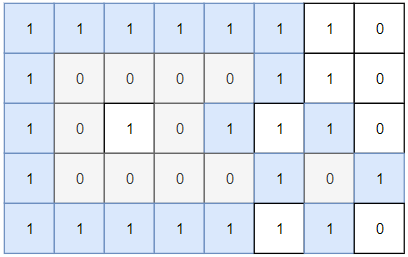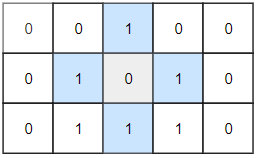1254. Number of Closed Islands
Given a 2D grid consists of 0s (land) and 1s (water). An island is a maximal 4-directionally connected group of 0s and a closed island is an island totally (all left, top, right, bottom) surrounded by 1s.
Return the number of closed islands.
Example 1:
Input: grid = [[1,1,1,1,1,1,1,0],[1,0,0,0,0,1,1,0],[1,0,1,0,1,1,1,0],[1,0,0,0,0,1,0,1],[1,1,1,1,1,1,1,0]]
Output: 2
Explanation:
Islands in gray are closed because they are completely surrounded by water (group of 1s).

Example 2:
Input: grid = [[0,0,1,0,0],[0,1,0,1,0],[0,1,1,1,0]]
Output: 1

Example 3:
Input: grid = [[1,1,1,1,1,1,1],
[1,0,0,0,0,0,1],
[1,0,1,1,1,0,1],
[1,0,1,0,1,0,1],
[1,0,1,1,1,0,1],
[1,0,0,0,0,0,1],
[1,1,1,1,1,1,1]]
Output: 2
Constraints:
- 1 <= grid.length, grid[0].length <= 100
- 0 <= grid[i][j] <=1
Solution
class Solution {
int[][] dirs = new int [][] {
{1, 0},
{-1, 0},
{0, 1},
{0, -1}
};
public int closedIsland(int[][] grid) {
int count = 0;
for (int i = 0; i < grid.length; i++) {
for (int j = 0; j < grid[0].length; j++) {
if (grid[i][j] == 0 && dfs(i, j, grid)) count++;
}
}
return count;
}
boolean dfs(int i, int j, int[][] grid) {
if (i < 0 || i >= grid.length
|| j < 0 || j >= grid[0].length) {
return false;
}
if (grid[i][j] == 1) {
return true;
}
grid[i][j] = 1;
boolean closed = true;
for (int[] dir: dirs) {
closed = closed & dfs(dir[0] + i, dir[1] + j, grid);
}
return closed;
}
}